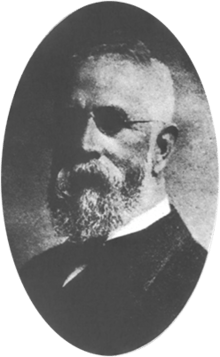George Newton Best
George Newton Best (October 16, 1846 – June 18, 1926) was an American bryologist, expert on moss taxonomy, and second president of the Sullivant Moss Society.[1][2]
George Newton Best | |
|---|---|
 | |
| Born | October 16, 1846 Round Valley, Clinton Township, New Jersey |
| Died | June 18, 1926 (aged 79) |
| Nationality | American |
| Alma mater | University of Pennsylvania |
| Known for | Plant taxonomy |
| Scientific career | |
| Fields | Bryology, Medicine |
| Institutions | Riegelsville High School |
| Author abbrev. (botany) | Best |
Biography
Best attended Lafayette College for three years before leaving to teach high school in Riegelsville, Pennsylvania. He resumed his education at the University of Pennsylvania, graduating with a degree in medicine in 1875. He took up his medical practice in Rosemont, New Jersey.[2]
Best was also a prominent bryologist, contributing often to Torrey Botanical Club publications. He was instrumental in revising and reclassifying many moss genera, including Thuidium, Claopodium, Heterocladium, Leskea, and Pseudoleskea.[3]
Best served as associate editor of The Bryologist from 1911 until his death, and as president of the Sullivant Moss Society from 1901 to 1902.[1][4] Best was also a member of the Medical Society of New Jersey, American Medical Association, and Torrey Botanical Club. He died on June 18, 1926.[5]
Legacy
Best's personal herbarium of mosses and publications were absorbed into the collection of the New York Botanical Garden.[5]
Selected publications
- Best, G. (1896). Revision of the North American Thuidiums. Bulletin of the Torrey Botanical Club, 23(3), 78-90. doi:10.2307/2478118
- Best, G. (1897). Revision of the Claopodiums. Bulletin of the Torrey Botanical Club, 24(9), 427-432. doi:10.2307/2477924
- Best, G. (1900). Revision of the North American Species of Pseudoleskea. Bulletin of the Torrey Botanical Club, 27(5), 221-236. doi:10.2307/2485378
- Best, G. (1901). Revision of the North American Species of Heterocladium. Bulletin of the Torrey Botanical Club, 28(2), 123-131. doi:10.2307/2477888
- Best, G. (1901). Vegetative Reproduction of Mosses. The Bryologist, 4(1), 1-3. doi:10.2307/3238870
- Best, G. (1903). Bulletin of the Torrey Botanical Club, 30(9), 463-482. doi:10.2307/2478535
The standard author abbreviation Best is used to indicate this person as the author when citing a botanical name.[6]
References
- Presidents of ABLS, The American Bryological and Lichenological Society, retrieved 2019-09-28.
- Snell, James P., and Franklin Ellis. History of Hunterdon and Somerset Counties, New Jersey: with Illustrations and Biographical Sketches of Its Prominent Men and Pioneers. Everts & Peck, 1881.
- Leonard, John W., and Albert N. Marquis. Who's who in America, Volumes 2-4. Marquis Who's Who, 1906.
- Smith, Annie Morrill. The Early History of the Bryologist and the Sullivant Moss Society. The Bryologist, vol. 20, no. 1, 1917, pp. 1–8. JSTOR, www.jstor.org/stable/3238019
- Beals, A. T. Dr. George N. Best, 1846-1926. The Bryologist, vol. 30, no. 2, 1927, pp. 20–22. JSTOR, www.jstor.org/stable/3238332
- IPNI. Best.